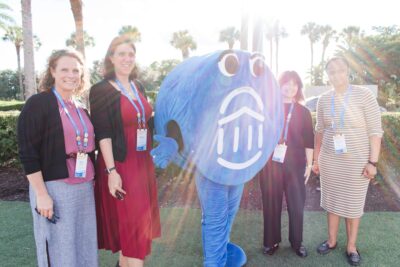Design academic support students will actually use
I didn’t set foot in my university’s tutoring center until junior year—and only because my Organic Chemistry professor offered extra credit for it. Like a lot of students, I didn’t think I was struggling enough to justify tutoring (though the fact that I was chasing extra credit probably should’ve been a clue). And as a transfer student, I wasn’t even sure where to go or how it worked.
I know now that my experience wasn’t unique, and years later, it still reflects the large disconnect between the support institutions offer and how students actually engage with it. In a recent episode of EAB’s Office Hours podcast, Ed Venit and Knack CEO Samyr Qureshi explored where current academic support models sometimes fall short and how institutions can rethink tutoring to meet students where they are. Below, I unpack their conversation about how technology can help campuses build support models students actually use.
-
More about Knack
Knack is a peer tutoring platform that connects college students with verified classmates who’ve excelled in the same courses. Sessions are offered online or in person, making it easier for students to get help from someone who understands exactly what they’re going through.
Today, expanding access to academic support is vital
Students are arriving on campus less academically prepared than in years past. EAB’s latest research on the student readiness crisis found that among incoming college freshmen, two-thirds aren’t reading at grade level, math scores are at a 14-year low, and only one in three high school seniors meet college readiness benchmarks in core subjects. Faculty are seeing the effects firsthand in the form of extension requests, missed assignments, and growing classroom disengagement. This isn’t just a student problem, it’s an institutional one: if you want to keep students enrolled and on track, tutoring can’t be treated as a last resort. It needs to be accessible from day one and embedded proactively into the student experience.
Learn How Two EAB Partners Are Expanding Access to Academic Support
4 barriers that keep students from using traditional tutoring services
1. Students don’t think they’re “struggling enough”
Many students assume tutoring is only for those who are failing. Students earning Bs or Cs often avoid it, unsure if they “deserve” the help.
- “Too often, tutoring feels like something you have to earn your way into needing.” – Samyr Qureshi
2. Today’s students expect flexible service, not fixed
Most tutoring centers operate like restaurants: fixed hours, limited offerings, and long waits during peak times. But today’s students may be juggling work, commutes, unpredictable schedules, and commitments outside the classroom. They often skip academic support that requires a specific time and place.
- Qureshi shared the story of a student who couldn’t find tutoring that fit her schedule so she and a classmate paid out of pocket to split a private tutor. It raises a pressing question: how many other students are quietly doing the same—and what happens to those who can’t afford to?
3. Many courses aren’t covered
Traditional centers tend to focus on high-enrollment, high-DFW classes. But students in upper-level or niche courses are often left without support. For those nearing graduation, that could be the difference between staying on track or falling behind.
- “Your catalog has thousands of courses,” Qureshi noted. “If your center only covers 30 or 40, where are the rest of those students going?”
4. Stigma is real
Even when students know where to go and when to show up, many feel embarrassed or uncertain about being seen seeking help—especially first-gen or underrepresented students who may already feel like they don’t belong.
How technology expands access to tutoring
Qureshi and Venit’s conversation made it clear that the next generation of tutoring can’t be tied to a physical center or a 9-to-5 schedule. Platforms like Knack are reshaping how support is delivered, removing friction and helping students get help when, where, and how they need it. By combining a peer-to-peer model with on-demand technology, Knack helps institutions scale academic support without overextending staff.
“Campuses already spend heavily on academic support,” Qureshi noted. “We help them make that investment go further.”
Here’s what that looks like in practice:
On-demand access fits students’ lives
Students can book sessions online or in person, often at night or on weekends, and access tutoring through platforms they already use like the LMS or Navigate360. The easier tutoring is to access, the more impact it has.
-
60%
of students using Knack have never engaged with any form of academic support on campus prior
Students who engaged weekly with Knack tutoring at the University of Florida had grades that on average were 18.5% higher than students who did not engage with Knack.
Course coverage goes beyond the basics
By filling in where traditional centers leave off, technology helps campuses offer support in more courses, especially upper-level and niche ones. By using Knack to match students with qualified peer tutors from their own campus, regardless of course size or subject, institutions bypass the staffing and scheduling limitations that often restrict traditional tutoring centers. With a larger tutoring pool and flexible session formats, institutions can offer help with a broader range of courses without needing to hire additional staff.
-
Up to 5x
Partner schools saw up to 5x more course coverage with Knack
Tutors build skills while supporting their peers
Knack hires high-achieving students from the institution’s own campus and manages onboarding, training, and scheduling. Tutors are paid directly by the institution, not out of students’ pockets, and gain valuable experience in leadership, communication, and time management—skills that directly address the gaps nearly 40% of new graduates say they face when entering the workforce.
-
Increase in Skills
Knack’s Tutor Skills Development Program led to a 10.6% increase in leadership skills and a 9.7% boost in critical thinking and problem-solving abilities among tutors at the University of Florida
Peer tutors reduce stigma and increase a student’s sense of belonging
Students are more likely to seek help when it comes from a peer: someone who understands their experience and makes tutoring feel less intimidating. That comfort opens the door to deeper connection. Many Knack sessions grow into broader conversations about classes, clubs, and career goals, helping students feel more at home on campus.
-
81%
of students said Knack tutoring helped them feel more connected to their campus community
Real-time data helps leaders make smarter decisions
Knack’s centralized dashboard shows who’s using tutoring, when, and for which courses—so schools can see where support is working and where it’s missing. This helps leaders improve not just peer tutoring, but also traditional support services by filling coverage gaps, adjusting hours, and focusing resources where students need them most. With better data, institutions can make tutoring more effective and accessible for everyone.
-
Expanded Peer Support
Using Knack’s analytics, the University of Florida identified tutoring gaps and successfully expanded peer support to over 550 unique courses, ensuring broader coverage where students needed it most
4 questions to start improving access to tutoring
-
#1
What percentage of our students actually use tutoring?
-
#2
Which high-enrollment or high-risk courses aren’t currently covered?
-
#3
Are we regularly collecting and acting on student feedback about academic support?
-
#4
Do our hours, formats, and messaging match students’ real lives and schedules?
Peer tutoring can fill critical gaps in supporting today’s students
I avoided the tutoring center for my first two years of college. Unfortunately, my experience is still being repeated on campuses everywhere: too many students are opting out, not because they don’t need help but because what’s currently offered doesn’t match how they live, learn, or ask for support. A student-led tutoring model can help scale up your academic support infrastructure and reach more students before they fall behind.

More Blogs

Four signs it’s time to break up with your student CRM

Three lessons from 1,200 student success leaders on higher ed’s future
